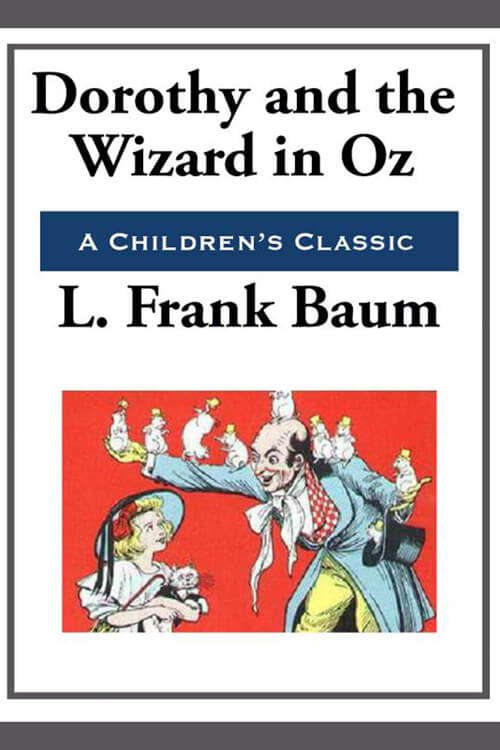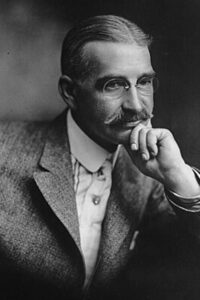
Dorothy and the Wizard in Oz
The train from ‘Frisco was very late. It should have arrived at Hugson’s Siding at midnight, but it was already five o’clock and the gray dawn was breaking in the east when the little train slowly rumbled up to the open shed that served for the station-house. As it came to a stop the conductor called out in a loud voice:
“Hugson’s Siding!”
At once a little girl rose from her seat and walked to the car door, carrying a wicker suitcase in one hand and a round birdcage covered with newspapers in the other, while a parasol was tucked under her arm. The conductor helped her off the car and then the engineer started his train again so that it puffed and groaned and moved slowly away up the track. He was so late because all through the night there were times when the solid earth shook and trembled under him, and the engineer was afraid that at any moment the rails might spread apart and an accident happen to his passengers. So he moved the cars slowly and with caution.
The little girl stood still to watch until the train had disappeared around a curve; then she turned to see where she was.
The shed at Hugson’s Siding was bare save for an old wooden bench and did not look very inviting. As she peered through the soft gray light not a house of any sort was visible near the station, nor was any person in sight; but after a while the child discovered a horse and buggy standing near a group of trees a short distance away. She walked toward it and found the horse tied to a tree and standing motionless, with its head hanging down almost to the ground. It was a big horse, tall and bony, with long legs and large knees and feet. She could count his ribs easily where they showed through the skin of his body, and his head was long and seemed altogether too big for him as if it did not fit. His tail was short and scraggly, and his harness had been broken in many places and fastened together again with cords and bits of wire. The buggy seemed almost new, for it had a shiny top and side curtains. Getting around in front, so that she could look inside, the girl saw a boy curled up on the seat, fast asleep.
Read or download Book
Lyman Frank Baum
Lyman Frank Baum (May 15, 1856 – May 6, 1919) was an American author best known for his children’s fantasy books, particularly The Wonderful Wizard of Oz, part of a series. In addition to the 14 Oz books, Baum penned 41 other novels (not including four lost, unpublished novels), 83 short stories, over 200 poems, and at least 42 scripts. He made numerous attempts to bring his works to the stage and screen; the 1939 adaptation of the first Oz book became a landmark of 20th-century cinema.
Born and raised in upstate New York, Baum moved west after an unsuccessful stint as a theater producer and playwright. He and his wife opened a store in South Dakota and he edited and published a newspaper. They then moved to Chicago, where he worked as a newspaper reporter and published children’s literature, coming out with the first Oz book in 1900. While continuing his writing, among his final projects he sought to establish a film studio focused on children’s films in Los Angeles, California.
His works anticipated such later commonplaces as television, augmented reality, laptop computers (The Master Key), wireless telephones (Tik-Tok of Oz), women in high-risk and action-heavy occupations (Mary Louise in the Country), and the ubiquity of clothes advertising (Aunt Jane’s Nieces at Work).
Later life and work
With the success of Wizard on page and stage, Baum and Denslow hoped for further success and published Dot and Tot of Merryland in 1901. The book was one of Baum’s weakest, and its failure further strained his faltering relationship with Denslow. It was their last collaboration. Baum worked primarily with John R. Neill on his fantasy work beginning in 1904, but Baum met Neill a few times (all before he moved to California) and often found Neill’s art not humorous enough for his liking. He was particularly offended when Neill published The Oz Toy Book: Cut-outs for the Kiddies without authorization.
Baum reportedly designed the chandeliers in the Crown Room of the Hotel del Coronado; however, that attribution has yet to be corroborated. Several times during the development of the Oz series, Baum declared that he had written his last Oz book and devoted himself to other works of fantasy fiction based in other magical lands, including The Life and Adventures of Santa Claus and Queen Zixi of Ix. However, he returned to the series each time, persuaded by popular demand, letters from children, and the failure of his new books. Even so, his other works remained very popular after his death, with The Master Key appearing on St. Nicholas Magazine’s survey of readers’ favorite books well into the 1920s.
In 1905, Baum declared plans for an Oz amusement park. In an interview, he mentioned buying “Pedloe Island” off the coast of California to turn it into an Oz park. However, there is no evidence that he purchased such an island, and no one has ever been able to find any island whose name even resembles Pedloe in that area. Nevertheless, Baum stated to the press that he had discovered a Pedloe Island off the coast of California and that he had purchased it to be “the Marvelous Land of Oz,” intending it to be “a fairy paradise for children.” Eleven-year-old Dorothy Talbot of San Francisco was reported to be ascendant to the throne on March 1, 1906, when the Palace of Oz was expected to be completed. Baum planned to live on the island, with administrative duties handled by the princess and her all-child advisers. Plans included statues of the Scarecrow, Tin Woodman, Jack Pumpkinhead, and H.M. Woggle-Bug, T.E. Baum abandoned his Oz Park project after the failure of The Woggle-Bug, which was playing at the Garrick Theatre in 1905.
His works anticipated such later commonplaces as television, augmented reality, laptop computers (The Master Key), wireless telephones (Tik-Tok of Oz), women in high-risk and action-heavy occupations (Mary Louise in the Country), and the ubiquity of clothes advertising (Aunt Jane’s Nieces at Work).






